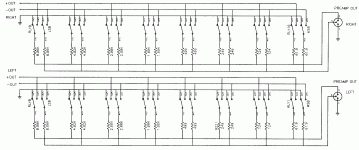Sorry the data are for the Aleph P, the predecessor of Aleph P1.7 ..... :-(
I forget this sometimes.
The topology is different. The volume controller data might be the same.
I forget this sometimes.
The topology is different. The volume controller data might be the same.
don't put the attenuator before the aleph. that will result in a noisy preamp. there is a reason that it is behind🙂
In pass B1 buffer preamp and in majority of cases we have the attenuator before the preamp and then followed by the main power amp.
(ie. source ---> attenuator ---> preamp --->power amp)
What is the reason for having volume control / attenuator after the preamp here?
(ie. source ---> preamp ---> attenuator ---> power amp)
Hi mr. PassHere is the schematic of the output shunt resistor network.
Thanks for the schematic of the attenuator ..
Could you please give some info regarding its placement , ie. Between the source and preamp or between preamp and power amp .. or it doesn't matter in either case ?
On b1 the volume potentiometer is between source and preamp buffer and in aleph preamp it's between the preamp and power amp ..
P1.7 - attenuator is in after electronic gain stage , meaning on output of preamp itself
besides taking my words as true ........ you can see XLRs on right end of picture
🙂
besides taking my words as true ........ you can see XLRs on right end of picture
🙂
Just wanted to understand what is the reason for putting the attenuator at the end of the preamp instead of at the beginning of the preamp as we more often see, for example in pass b1 preamp .. could you please give some info regarding this ..
Just wanted to understand what is the reason for putting the attenuator at the end of the preamp instead of at the beginning of the preamp as we more often see, for example in pass b1 preamp .. could you please give some info regarding this ..
The answer is in the line you quoted from me. Aleph P1.7 have some noise.
I think Papa just wanted to take advantage of Aleph P being able to drive any load so he stuck a 1kOhm attenuator behind it, so any noise contributed by the preamp itself also gets attenuated (a purist approach I guess). since that brings the output impedance up shorter leads (up to 3 feet) to the following amp stage are recommended.
Aleph P itself does not like a hot input and there are attenuating resistors with dip switch settings at the input to drop the level if necessary.
Aleph P itself does not like a hot input and there are attenuating resistors with dip switch settings at the input to drop the level if necessary.
...what is the reason for putting the attenuator at the end of the preamp instead of at the beginning of the preamp as we more often see....
From the now-secret Service Manual:
The volume control system ... ... to achieve good common mode rejection performance, the output attenuation must be matched far more precisely than can be accomplished with potentiometers, and so relays and precision resistors are used.
Yes, this is "different". Mr Pass is known for re-thinking conventional methods. We normally pot first then line-amp, so we won't overload the line-amp.
Pass was working with BIG devices at high voltage. Overload won't happen.
These devices "may" have more hiss than conventional designs (I am not an expert on this). Pot first puts turned-down signals close to hiss. Bringing signal in un-reduced gives best signal/hiss ratio.
We don't normally pot after the line amp (though I know a few which pot before and after, much $$$). With conventional line amps this is a waste of line-amp output, and also messes with the impedance at a point which may be driving long cables. But again Pass was working with BIG devices idling at high power, and these conventional trade-offs were re-thought.
It looks fine to me. Not the thriftiest music-box around, but sometimes that is not the point, the music is.
Worth noting, there were additional gain controls via pots between the
Sources of the Mosfets, degenerating the gain, and were used as balance
controls. In spite of better numbers with maximum degeneration, most
users preferred a high gain setting, even if it meant running the output
volume control low.
Sources of the Mosfets, degenerating the gain, and were used as balance
controls. In spite of better numbers with maximum degeneration, most
users preferred a high gain setting, even if it meant running the output
volume control low.
..... resulting in lesser drain impedance load value , meaning harder load .......
oh ....... it's hard to try every road to Rome
🙂
oh ....... it's hard to try every road to Rome
🙂
- Status
- Not open for further replies.
- Home
- Amplifiers
- Pass Labs
- Aleph P 1.7 Volumecontrol Output-imendance question
